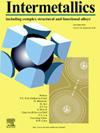Relative phase stability of L12 and DO22/DO23 structures in Al3Nb, Al3Zr and Al3V compounds
IF 4.3
2区 材料科学
Q2 CHEMISTRY, PHYSICAL
引用次数: 0
Abstract
The relative stability of the different tri-aluminide (Al3M) phases in three binary systems (M = Zr, Nb and V) was assessed for their potential to form fine cubic L12 precipitates in additively manufactured alloys. Supersaturated thin films of Al-(8–30) at% M were sputtered and heat treated during in-situ x-ray diffraction (XRD) measurements to observe the temperature ranges of stability for each phase. As-sputtered films were then processed with laser tracks simulating additive manufacturing solidification conditions, and the formation of phases in the laser tracks was correlated with density functional theory (DFT) and nucleation rate calculations. We found that the metastable L12 structure is highly competitive with the stable DO23 structure in the Al-Zr system, but much less stable than the DO22 structure in the Al-Nb system, and both the DO22 and Al8V5 structure in the Al-V system. These experimental results were found to be in good agreement with the DFT and kinetic calculations, as we determined that the metastable L12 in Al-Zr only requires a small amount of undercooling to favor its nucleation over the stable DO23, suggesting additive manufacturing can be a viable pathway to develop Al-Zr alloys strengthened by a high volume fraction of L12 Al3Zr phase.

Al3Nb, Al3Zr和Al3V化合物中L12和DO22/DO23结构的相对相稳定性
研究了三铝化物(Al3M)相在3种二元体系(M = Zr, Nb和V)中形成细小立方L12析出相的可能性,并对其相对稳定性进行了评价。通过原位x射线衍射(XRD)测量,对% M的Al-(8-30)过饱和薄膜进行了溅射和热处理,观察了各相的稳定温度范围。利用模拟增材制造凝固条件的激光轨迹对溅射薄膜进行加工,激光轨迹中相的形成与密度泛函理论(DFT)和成核速率计算相关。我们发现,在Al-Zr体系中,亚稳的L12结构与稳定的DO23结构具有很强的竞争性,但远不如Al-Nb体系中的DO22结构以及Al-V体系中的DO22和Al8V5结构稳定。这些实验结果与DFT和动力学计算结果一致,因为我们确定Al-Zr中亚稳的L12只需要少量过冷就可以比稳定的DO23更有利于其成核,这表明增材制造可以是开发高体积分数L12 Al3Zr相强化的Al-Zr合金的可行途径。
本文章由计算机程序翻译,如有差异,请以英文原文为准。
求助全文
约1分钟内获得全文
求助全文
来源期刊

Intermetallics
工程技术-材料科学:综合
CiteScore
7.80
自引率
9.10%
发文量
291
审稿时长
37 days
期刊介绍:
This journal is a platform for publishing innovative research and overviews for advancing our understanding of the structure, property, and functionality of complex metallic alloys, including intermetallics, metallic glasses, and high entropy alloys.
The journal reports the science and engineering of metallic materials in the following aspects:
Theories and experiments which address the relationship between property and structure in all length scales.
Physical modeling and numerical simulations which provide a comprehensive understanding of experimental observations.
Stimulated methodologies to characterize the structure and chemistry of materials that correlate the properties.
Technological applications resulting from the understanding of property-structure relationship in materials.
Novel and cutting-edge results warranting rapid communication.
The journal also publishes special issues on selected topics and overviews by invitation only.
 求助内容:
求助内容: 应助结果提醒方式:
应助结果提醒方式:


